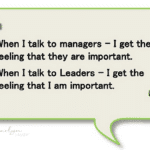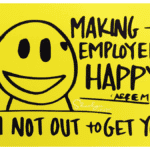(Editor’s Note: Today’s post is brought to you by our friends at SilkRoad, whose passion is creating a world-class employee experience. I just returned from their annual users’ conference – three days of networking, education and fun. I wrote a post about their great event over on the SilkRoad blog. Hope you’ll check it out here!)
According to SilkRoad’s TalentTalk Research Program, the most popular way companies measure employee engagement is via their annual employee survey (59%). Since employee surveys should never be done haphazardly, this puts the development, implementation and communication of an employee survey front and center.
Employee opinion surveys are used for a variety of reasons. I’ve always looked at them as a way to converse with employees about the workplace. They provide a tremendous amount of data. But I believe it’s short-sighted to view them as a report card about how things are going. Because while there’s a lot of data that is gleaned from surveys, it’s never the whole story.
Surveys offer the ability to receive feedback at every level:
Organizationally, a survey can identify company strengths and weaknesses. It can confirm if actions align with corporate mission and values.
Departmentally, employees can share their views on job responsibilities, department safety, work environment, and relationship with their manager.
Individually, the survey can offer feedback about company benefits, career development, and compensation.
Before you start designing your survey, take the time to get management and employees comfortable with the process. One thing you will want to do is bring in a third party to administer the survey. It’s not because the company isn’t capable of conducting a survey. But creating an atmosphere of confidentiality and anonymity is important. If employees feel their comments aren’t being taken in the spirit of improving the workplace, they won’t share information freely. And managers need to understand this isn’t some subversive move to fire them.
The first rule in designing an employee survey is don’t ask anything you’re not prepared to change. Or at least consider changing. There’s nothing worse than asking someone for their opinion then ignoring it. Ultimately, it hurts the credibility of the survey and employees won’t want to participate.
Some other items to consider when designing your employee survey:
Length – There’s a delicate balance between “just right” and “too much”. The company is looking for valuable information. Keep the length of the survey manageable. After designing the survey, have a few coworkers take it and time themselves – for practice only – so you can communicate how long it will take to complete the survey.
Comments – Allow employees to include comments. This is tremendously rich information. If you use a third party to administer the survey, they should be able to scrub any identifiers out of the comments so they remain truly anonymous.
Questions/Statements – Be careful not to create any biased or leading questions.
Benchmarking – Create a few questions that you will use in future surveys to benchmark trends in the workforce. Also include an “intent to stay” question for use as a retention score.
After the survey has been conducted and the reporting complete, then begins the most important part of the process – communicating the survey results. This is an absolute must. Communicating results must be done in a timely manner to the entire workforce. There are many ways to communicate results – all employee meetings, department meetings, or a combination of both.
All employee meetings are an efficient way to communicate results. Some companies already have a regular all staff meeting or town hall type gathering in place. The downside can be trying to create some dialogue if it’s a large meeting. This can be addressed a couple of ways:
One option is to give each employee an index card. Have them write any questions or comments they may have on it (don’t require them to include their name). Someone can collect the cards to ask the questions. Similar to an interview format.
Another option is to allow employees to work in groups to develop questions. They can identify a spokesperson in their group to ask the question. It still allows for anonymity because the table conversation stays amongst the employees. And it’s unknown how much the spokesperson was involved in the discussion.
Department meetings are great from a scheduling standpoint as well. Most departments have a regularly scheduled meeting. It’s also a smaller gathering and allows for a different level of conversation. This can be a challenging meeting for managers. I’ve often seen managers in a panic that employees are going to gang up on them during a department meeting. Preparing managers for open dialogue and constructive feedback is important to the success of this meeting.
I’ve always found a combination of the two to be the best approach. Each has their own agenda of items to discuss. The conversation gets more detailed and less formal as it moves from a large all employee meeting to the smaller department meeting. Ultimately leading to individual conversations between managers and employees. That’s where the opportunity to create engagement occurs.
Employee opinion surveys are a valuable way to take a pulse on the workforce. And they provide great data. But it’s the meetings and conversations after the survey that provide the foundation for improving the workplace and the essentials of employee engagement.
If you want to see more of SilkRoad’s latest employee engagement study, check out this infographic they created using the report data. You can also check out their website, follow them on Twitter and subscribe to their YouTube channel.








Mohit Garg says
Thank you for this. Could you also share any sectoral trends that you have seen when it comes to employee engagement?
e.g. do surveys work well in manufacturing as compared to technology?
Catie Farrow says
Thanks Sharlyn for bringing this important topic to light! Agreed that the most important part of the employee engagement survey is the conversation at the end. My team finds department meetings to be incredibly effective – not only does it give us a chance to discuss specific pain points and likely fixes, but it also reinforces the fact that our Employee Success is truly dedicated to our progress. Certain issues vary in degree by department, and these conversations allow us to clear the air within our team, as well as set specific and actionable plans in motion to help ease those tensions. I certainly wish other companies I’ve worked at believed in this process!
Sharlyn Lauby says
Thanks so much for the comments!
SilkRoad’s data analysis did not include sectoral trends in measuring employee engagement, though they tell me that they will be looking at this closely in future surveys.
They did share that the annual employee survey remains the predominant tool for measuring engagement (58% in 2012 and 59% in 2013). And in a year-over-year comparison of the ways corporations measure engagement, the methods remained similar in 2012 and 2013, e.g. town hall meetings, one-on-one interviews.
Snizhana says
Hey Sharlyn,
Really liked your article. Hope you don’t mind me sharing it on LinkedIn.
Jennifer says
One of the emerging trends in employee engagement is the creation of goals groups. They are small groups of 4-6 employees who meet weekly to help each other achieve personal and work-related goals. The Incept Corporation has been doing this since 2008. One reason it works so well for Incept is because the president sponsored the goals groups initiative and is in a goals group of his own. It doesn’t cost much to foster employee engagement using goals groups. Employees feel more valued and more invested in each others’ success.
Katherine Razzi says
Hi Sharlyn!
You are right on target with the survey cycle and each point is made well. That’s what we do here at TNS Employee Insights; not only do we create the surveys, but we collect the data, create reports, help management create action plans, and advise best practices. However, it runs deeper than that. Out of the scientific data, we are still dealing with the human element, of which, as you say, allowing employees to comment renders “tremedously rich information.” I’ve been working at TNS for almost 5 years now, and have noted many of our clients, large and small companies, truly rely on this data to solve problems and also to reap the compliments of the many good things they do for their employees. Now, with the help of ever-evolving technology, we’re going one step further: We’re combining CUSTOMER data with EMPLOYEE data! Between customer and employee satisfaction there’s a definite link. This big data can prove to be very interesting and really hone into the pain points within a company. If you’re interested to know more details, let me know.
Grapevine Surveys says
Thanks for the in-depth article Sharlyn. I’ve seen evidence of how much employee engagement matters for years, and yet so few companies bother to actually MEASURE the impact on their bottom line. Hopefully your article helps them realize 😉